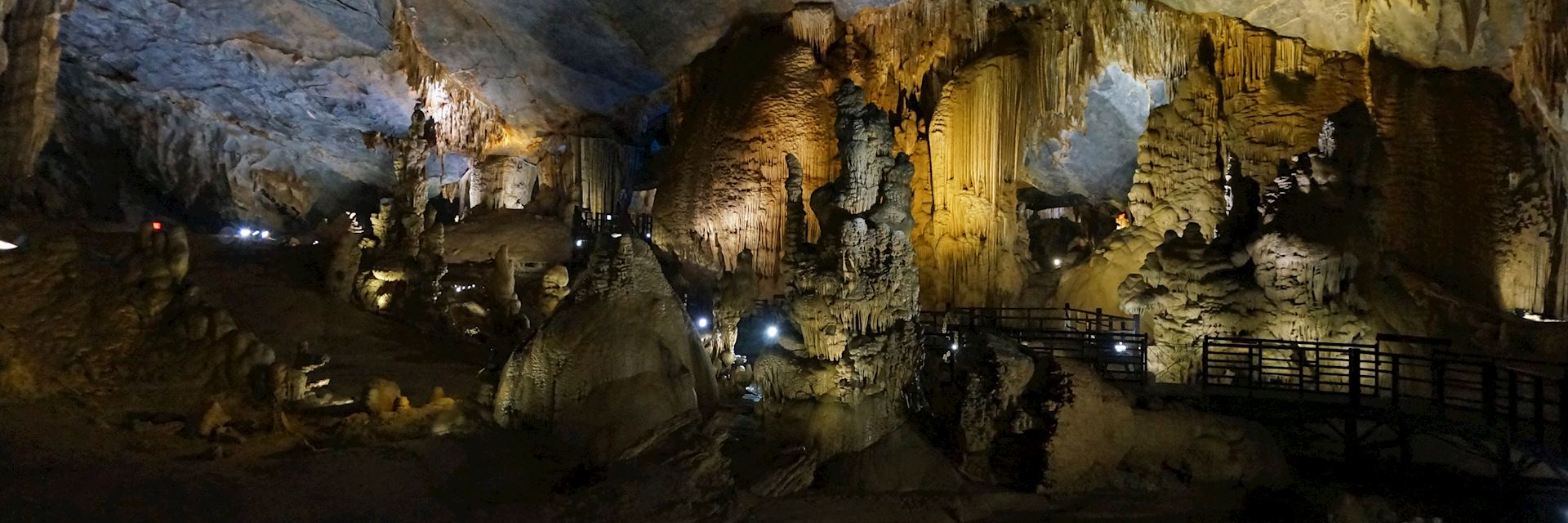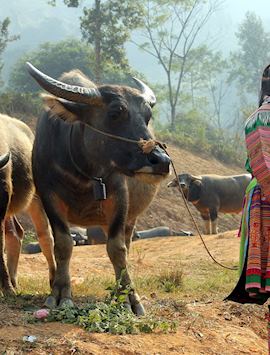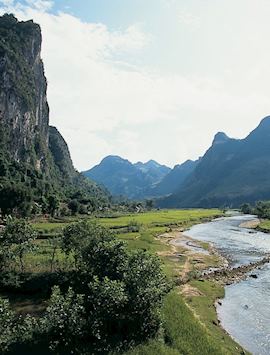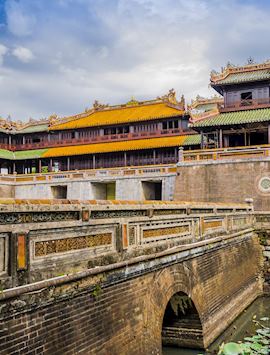By Vietnam specialist Georgia
While out hunting in Phong Nha-Ke Bang National Park in 1990, local villager Ho Khanh stumbled across an opening in a limestone cliff so large that clouds drifted out of the entrance and he could hear a river raging inside. This set speleologists’ senses tingling, and the region has been at the forefront of cave exploration ever since.
Some of the caves now have electric lighting and see a throng of regular visitors. Others you can only reach by a multi-day jungle trek. I’ve focused on some of the region’s best experiences, below and above ground, which you could include on an adventurous trip across Vietnam.
About Phong Nha-Ke Bang National Park
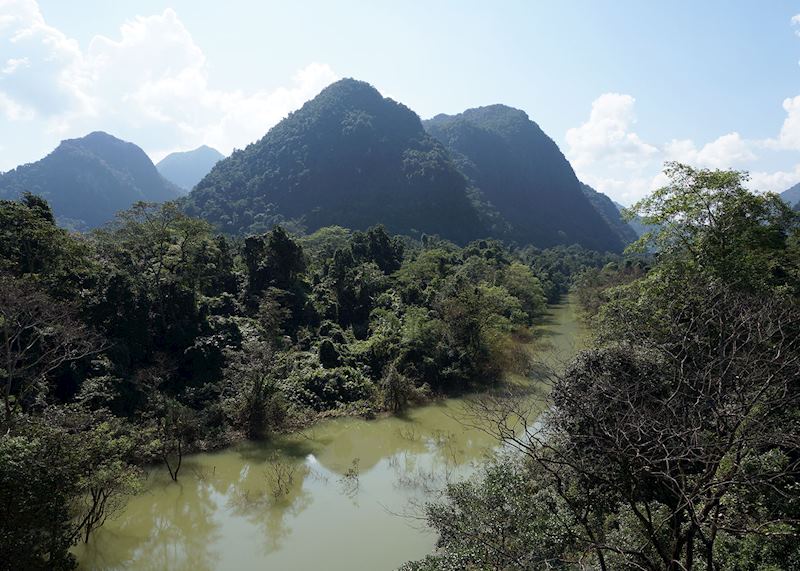
A World Heritage Site since 2003, Phong Nha-Ke Bang National Park protects a portion of the Annamite Range, which runs westward into Laos. These are the oldest karst mountains in Asia and, thanks to hunter-turned-caver Ho Khanh and the British Cave Research Association (BCRA), more than 300 caves have been mapped so far.
Despite his best efforts, it took Khanh 20 years to rediscover that original cave opening, which he named Hang Son Doong (mountain river cave). Big enough to swallow a New York City block or serve as a hangar for a jumbo jet, it turned out to be the largest known cave in the world. Khanh now works as a caving guide. And, with the support of the BCRA, other local people have been trained as guides or porters, providing valuable opportunities in Quang Binh, one of Vietnam’s poorest provinces.
The park and its surroundings are laced with fragments of the Ho Chi Minh Trail, the supply lines for the Viet Cong and North Vietnamese troops during the Vietnam War. As I journeyed through the region, my guide pointed out the occasional dark-green circle, eye-catching against the pale rice crops — bomb craters.
How to get to the Phong Nha region
Phong Nha is about an hour’s drive from Dong Hoi Airport, which has direct flights from Hanoi. Or alternatively, make the four-hour drive to Vietnam’s imperial city of Hue via the Vinh Moc war tunnels, or a five and a half hour journey by local train to Hoi An, passing over the scenic Hai Van Pass.
Paradise Cave
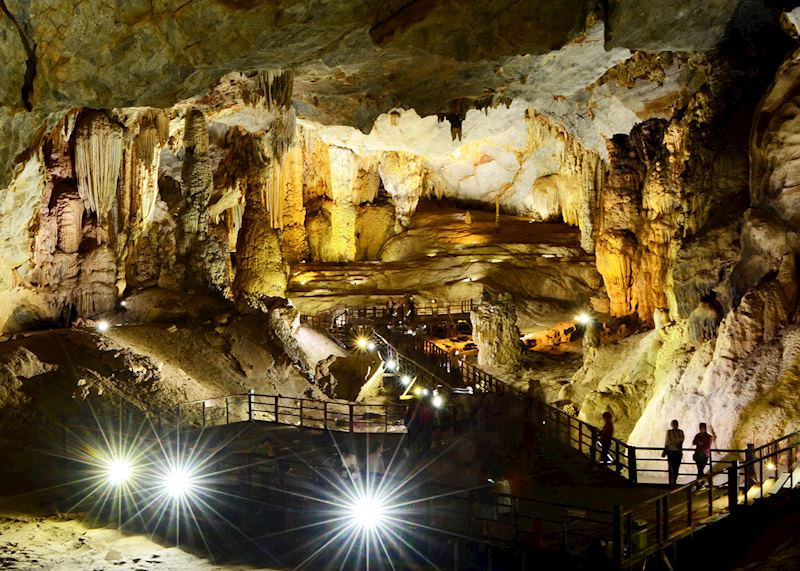
A group of besotted Yorkshiremen from the BCRA named Paradise Cave, after mapping its 31 km (19 mile) length. Discovered in 2005, the cave is an ethereal complex of skyscraper-high stalagmites, and stalactites that hang like the pipes of oversized church organs. The first 1 km (0.6 miles) is open to visitors and lit with the aplomb of a cathedral, with wooden steps and walkways navigating the uneven floor.
When you arrive at the cave site, don’t panic if there are a large number of visitors. It’s Phong Nha’s most popular (and accessible) cave, so it can get busy. But, the cave’s vastness swallows the crowds once you’re inside. Buggies run (for a small fee) from the car park along a narrow jungle path, then it’s a walk up 500 steps to the cave entrance itself.
The cave’s narrow opening leads you down to 283 more steps and then the cave bed, which opens out into a cathedral-like space. Each section has been named after its defining feature, from the ‘Waterfall from Heaven’ to the largest open section, known as the ‘Meeting Room’.
Phong Nha Cave
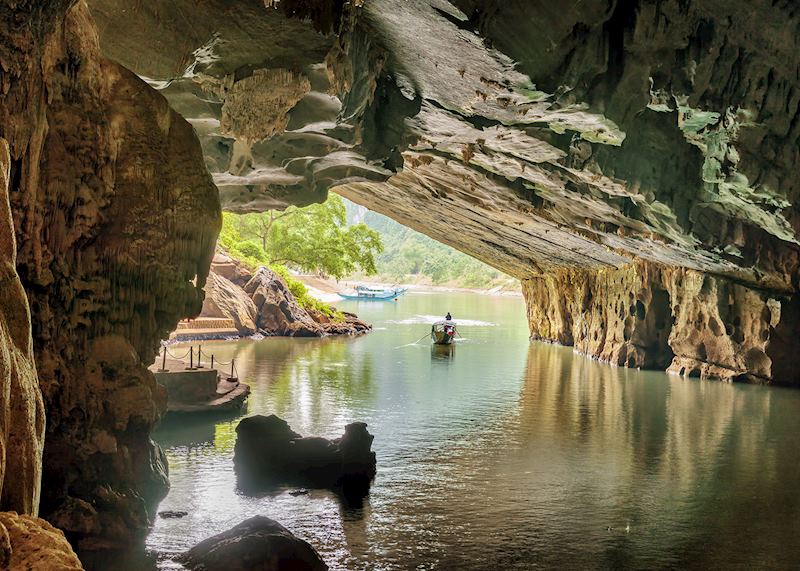
Phong Nha translates as ‘wind and teeth’ — apt for the milky-white stalagmites and stalactites inside. Part of the Ho Chi Minh Trail, the cave was used as a hospital and munitions store during the Vietnam War.
The Son River that originally carved the cave still runs through it, meaning you can visit by longtail boat. It’s a leisurely half-hour trip along the river before your boat driver cuts the engine to paddle through the relatively nondescript entrance.
Inside, the cave opens out and walls of stalactites, Gaudí-like in their shape, are illuminated by electric lighting. A series of grottoes and caverns stretch out for 8 km (5 miles). Your boat takes you about 1.5 km (1 mile) into the cave, where you’ll step onto a subterranean beach. From here, you follow a circular route around Cung Dinh (Court Cave), a cavern named after a formation said to resemble a throne flanked by elephants (you’ll need a little imagination).
Hang En Cave trek
There’s something very special about sleeping in a cave. And, to visit Hang En Cave, that’s just what you’ll do. The largest (and, I’d argue, most spectacular) caves in Phong Nha are in the deepest, darkest pockets of jungle, only reachable by (at least) a day’s trek. This inaccessibility is the park’s defining feature — only a very small group of visitors are allowed in each day, keeping the environment as pristine as possible. Local staff run the tours, using a ‘leave no trace’ ethos.
A number of treks are available, ranging from one to four days. The trek to Hang En, the world’s third-largest cave by volume, is a two-day experience as part of a small group. You’ll require a good level of fitness for the 22 km (13 miles) of hiking and 4 km (2.4 miles) of caving.
You start with an early-morning safety briefing before the drive into the park. When my group stepped out of our minibus, we weren’t sure why we’d stopped — the thick foliage almost obscured the trailhead.
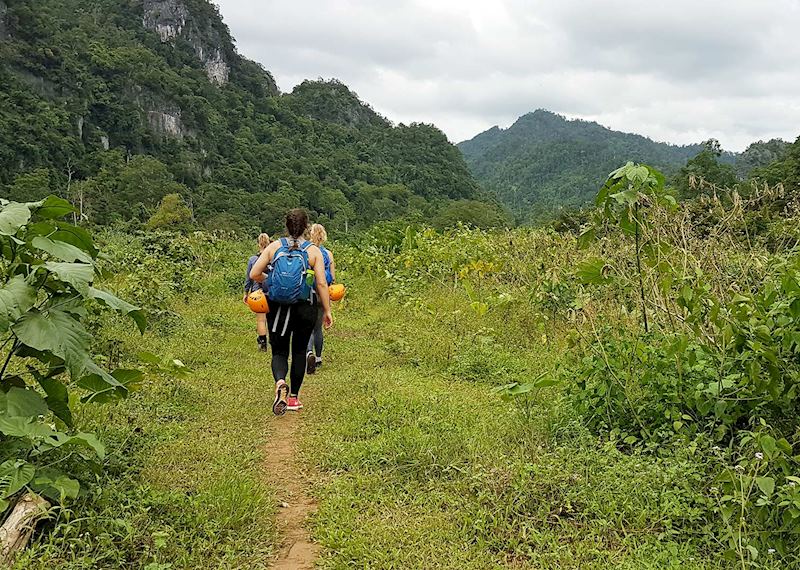
Our guide, Ksana, slipped through clusters of fan palms and led us into the jungle proper, along a narrow trail that steered us steeply down into the valley below. It’s a challenging start, but after an hour or so the evergreen forest gradually opens out and you’re walking along the flat basin floor. The Song Con River lies along the valley floor like a coiled snake, running clear over polished boulders and pebbles.
Ksana and our porters didn’t see this fast-flowing water as an obstacle at all, powering straight through it to the other side. I crossed the first few rivers with the stability of a baby deer, but, countless crossings later, we were all wading with confidence. The occasional water buffalo joined us by the water, and every now and again the greenery would flicker with the lemon-yellow or orange of a butterfly.
Lunch is in Ban Doong, a village whose small collection of stilted wooden houses seem to appear miraculously out of the jungle. Home to a small ethnic minority tribe, Ban Doong is the only settlement in the park. During the yearly floods, villagers stay stranded in their homes for weeks at a time. Our meal of fresh summer rolls was overseen by the tribe’s matriarch, a tiny gap-toothed old lady who watched us through a continuous plume of pipe smoke.
Your first view of Hang En Cave is a gaping archway in a limestone cliff, a multi-storey pile of boulders blocking the entrance. You’ll don a caving hat and gloves (to grip slippery rocks) and enter via a narrow cleft in the rock to the side, which follows the Rao Thuong River deep into the cave system. To reach the main chamber, it’s a clamber up-and-over a series of rocks, ending up at the edge of a subterranean lake.
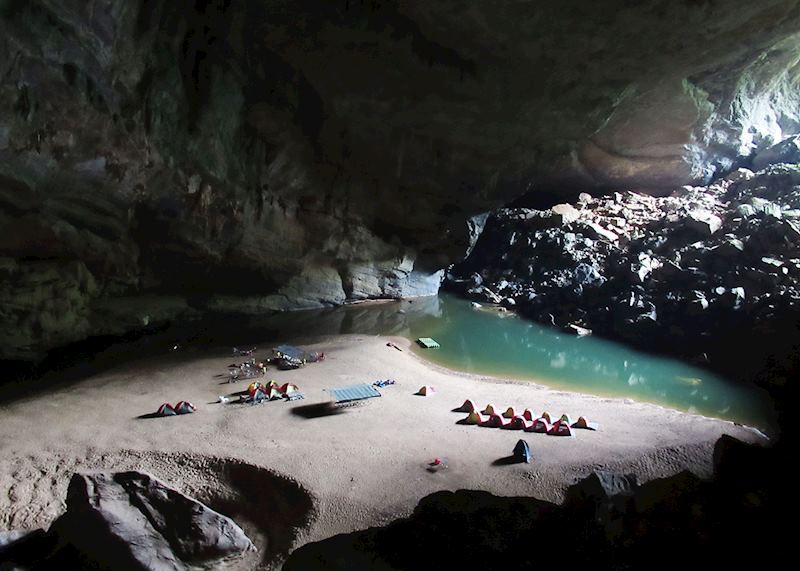
A raft takes you across the lake, where a row of tents line up neatly on a dark-sand beach, the cave walls stretching more than 100 m (328 ft) above. A pop-up kitchen will already be functioning when you arrive, as well as the toilet tents. Shafts of light filter through an opening above and, as the light dims, you’ll see shimmering clouds of black swifts coming home to roost.
There’s time for a swim before an evening meal by torchlight and a chance to try a tipple of rice wine (which they store in water bottles: take my experiential advice and don’t confuse the two).
The next morning, you head farther into the cave. You can shine a headlamp at all manner of formations, from shallow rimstone ponds to clusters of stalactites. Stretched out on a boulder was a death's-head hawkmoth, its wingspan longer than my hand. Our guide shone her torch past it to point out a series of faded white circles in the rock — coralline fossils estimated to be about 300 million years old.
You spend the rest of the second day trekking, wading and clambering back through the jungle. At rest stops along the way, keep an eye out for kaleidoscopes of butterflies that settle on riverside pebbles to feed. Don’t get too close, though, because they’re likely to be drinking from the sugary urine of water buffalo.
The last section of the hike is a tough uphill walk through jungle so thick that the screech of cicadas and crickets is almost deafening. As you clear the peak of the basin’s ridge and emerge onto the roadside, a cold beer and a panoramic view of the tree canopy are waiting.
Where to stay in Phong Nha

The first thing I noticed at Chay Lap Farmstay was the hand, the height of a house, emerging from the lawn, motioning toward the pool. It’s a prop gifted from the 2005 film King Kong, which was shot in the region. A crumpled limestone ridge, frothy with dark-green foliage, looms over the hotel, making the pool look more out of place than the monster’s hand.
Chay Lap Farmstay is a community-owned and run hotel, created to give the residents of the tiny Chay Lap village gainful employment. It’s not the most luxurious affair, but the rooms and cottages are comfortable and surrounded by neat rows of organic tomatoes, lemongrass and bamboo shoots. You’re welcome to help out on the farm, or you can simply enjoy the spoils in the restaurant — I particularly recommend the goi xoai (green mango salad).
The farmstay is a half-hour drive from the caves. You can spend a day cycling in its rural surroundings or relaxing by the hotel’s riverside café, which hires out kayaks and coracles.
Read more about trips to Vietnam
Start thinking about your experience. These itineraries are simply suggestions for how you could enjoy some of the same experiences as our specialists. They’re just for inspiration, because your trip will be created around your particular tastes.
View All Tours in Vietnam
